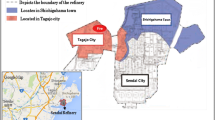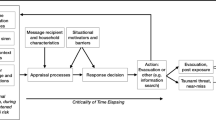Abstract
With increasing concerns over the possibility of tornadoes in highly populated areas in Canada, emergency managers are looking into ways to mitigate the impacts of tornadoes. Given that tornadoes can cause enormous destruction, early warnings and proper evacuation actions are critically important in helping save lives. In this paper, a survey was conducted to analyse the evacuation behaviour of households and drivers during a hypothetical tornado warning situation in the city of Calgary, Alberta. Nearly 500 Calgarians took part in the online survey and provided information on how they would respond to tornado warnings after receiving them. This paper presents the results of the survey. Using probit models, the factors influencing these evacuation decisions are identified and discussed in detail. The results of the household evacuation model show the importance of improving awareness about the safest locations during a tornado. It further highlights the need for targeting the population under the age of 30, who are more likely to take unsafe evacuation actions. The model for evacuation of drivers shows that several factors, such as knowing the difference between a watch and a warning, awareness of safe cover, receipt of warnings through natural environmental cues and the level of education, trigger evacuation actions in avoiding a tornado threat.





Similar content being viewed by others
References
Abdelgawad H, Abdulhai B (2009) Emergency evacuation planning as a network design problem: a critical review. Trans Lett Int J Trans Res 1:41–58
AEA (2013) Alberta Emergency Alert. Government of Alberta, http://www.emergencyalert.alberta.ca/. Accessed 19 June 2013
Bartlett JE, Kotrlik JW, Higgins CC (2001) Organizational research: determining appropriate sample size in survey research. Inf Techno Learn Perform J 19(1):43–50
Ben-Akiva ME, Lerman SR (1985) Discrete choice analysis: theory and application to travel demand. The Massachusetts Institute of Technology, USA
Blanchard-Boehm RD, Cook MJ (2004) Risk communication and public education in Edmonton, Alberta, Canada on the 10th Anniversary of the ‘Black Friday’ Tornado. Int Res Geogra Environ Edu 13:38–54
Dash N, Gladwin H (2007) Evacuation decision making and behavioural responses: individual and household. Nat Hazards Rev 8:69–77
Donner WR, Rodriguez H, Diaz W (2012) Tornado warnings in three southern states: a qualitative Analysis of public response patterns. J Homeland Secur Emerg Manag 9(2):1547–7355 ISSN (Online)
Dotto L, Duchsne L, Etkin D et al (2010) Canadians at risk: our exposure to natural hazards, Canadian assessment of natural hazards project. Institute for Catastrophic Loss Reduction, Ontario
Drury J, Cocking C, Reiche S, Burton A, Schofield D, Hardwick A, Graham D, Langston P (2009) Cooperation versus competition in a mass emergency evacuation: a new laboratory simulation and a new theoretical model. Behav Res Method 41(3):957–970
Durage SW, Wirasinghe SC, Ruwanpura JY (2013) Comparison of the Canadian and U.S. Tornado detection and warning systems. Nat Hazards 66(1):117–137
EC (2013) What is Weatheradio? http://www.ec.gc.ca/meteo-weather/. Accessed 19 June 2013
Etkin D (1995) Beyond the year 2000, more Tornadoes in Western Canada? Implications from the historical record. Nat Hazards 12:19–27
Grazulis T P (1991) Significant Tornadoes, 1880–1989, Vol I, Discussion and analysis, Environmental Films, St. Johnsbury Vt., 526
Hammer BO, Schmidlin TW (2001) Vehicle-occupant deaths caused by tornadoes in the United States, 1900–1998. Environ Hazards 2(3):105–118
Hosmer DW, Lemeshow S, Sturdivant RX (2013) Applied logistic regression, 3rd edn. Wiley, New Jersey
Kockelman K, Kweon Y (2002) Driver injury severity: an application of ordered probit models. Accid Anal Prev 34(3):313–321
Kwak C, Matthews AC (2002) Multinomial logistic regression. Nurs Res 51(6):404–410
Louviere JJ, Hensher DA, Swait JD (2000) Stated choice methods analysis and applications. Cambridge University Press, UK
Mahapatra K, Kant S (2005) Tropical deforestation: a multinomial logistic model and some country-specific policy prescriptions. For Policy Econ 7:1–24
Matyas C, Srinivasan S, Cahyanto I, Thapa B, Pennington-Gray L, Villegas J (2011) Risk perception and evacuation decisions of Florida tourists under hurricane threats: a stated preference analysis. Nat Hazards 59:871–890
McCarthy P (2010) Prairie and Northern Region Severe Weather Database (1826-2010). Prairie and Arctic Storm Prediction Centre, Environment Canada, CD-ROM
Mileti D, O’Brien P (1992) Warning during disaster: normalizing communicated risk. Soc Probl 39(1):40–55
Monfredo W (2008) Blown away in Greensburg, USA: prediction and analysis of an EF-5 tornado. Weather 63(5):116–120
Murphy B, Falkiner L, McBean G et al (2005) Enhancing local level emergency management: the influence of disaster experience and the role of households and neighbourhoods, ICLR Research Paper Series-No 43. Institute for Catastrophic Loss Reduction, Ontario
Nirupama N (2012) Risk and vulnerability assessment: a comprehensive approach. Int J Disaster Resilience Built Environ 3(2):103–114
Nirupama N, Maula A (2013) Engaging public for building resilient communities to reduce disaster impact. Nat Hazards Nat Hazards Special Issue Sociol Aspects Nat Disasters 66:51–59
NOAA (2012) Mobile weather warnings on the way! http://www.noaa.gov/features/03_protecting/wireless_emergency_alerts.html Accessed 6 June 2013
Oxendine C, Sonwalkar M, Waters N (2012) A multi-objective, multi-criteria approach to improve situational awareness in emergency evacuation routing using mobile phone data. Trans GIS 16(3):375–396
Pfarr C, Schmid A, Schneider U (2011) Estimating ordered categorical variables using panel data: a generalized ordered probit model with an autofit procedure. J Econ e´conom 54(1):7–23
Robinson M, Khattak A (2010) Route change decision-making by evacuees facing congestion. Trans Res Rec J Trans Res Board 2196:168–175
Schmidlin TW, King PS, Hammer BO, Ono Y (1998) Behaviour of vehicles during Tornado winds. J Saf Res 29(3):181–186
Schmidlin TW, Hammer BO, Ono Y, King PS (2009) Tornado shelter-seeking behaviour and tornado shelter options among mobile home residents in the United States. Nat Hazards 48:191–201
Schultz DM, Gruntfest EC, Hayden MH, Benight CC, Drobot S, Barnes LR (2010) Decision making by Austin, Texas, residents in hypothetical Tornado scenarios. Weather Clim Soc 2:249–254
Sherman-Morris K (2010) Tornado warning dissemination and response at a university campus. Nat Hazards 52:623–638
Slovic P (2000) The perception of risk. Earthscan Publications ltd, USA
SPC (2013) The Online Tornado FAQ. http://www.spc.noaa.gov/faq/tornado/ Accessed 29 July 2013
Tay R, Barua U, Kattan L (2009) Factors contributing to hit-and-run in fatal crashes. Accid Anal Prev 41:227–233
Wickramaratne S, Ruwanpura JY, Wirasinghe SC (2011) Decision analysis for a tsunami detection system—Case Study: Sri Lanka. Civil Eng Environ Sys 28(4):353–373
Williams R (2006) Generalized ordered logit/partial proportional odds models for ordinal dependent variables. State J 6(1):58–82
Ye Z, Chaudhari J, Booth J, Posadas B (2010) Evaluation of the use of rural transportation infrastructure in evacuation operations. J Trans Saf Sec 2:88–101
Acknowledgments
The authors wish to acknowledge the assistance of the Calgary Emergency Management Agency (CEMA), particularly Director of CEMA and Fire Chief Bruce Burrell, in conducting this research, as well as that of the Natural Sciences and Engineering Research Council of Canada (NSERC).
Author information
Authors and Affiliations
Corresponding author
Rights and permissions
About this article
Cite this article
Durage, S.W., Kattan, L., Wirasinghe, S.C. et al. Evacuation behaviour of households and drivers during a tornado. Nat Hazards 71, 1495–1517 (2014). https://doi.org/10.1007/s11069-013-0958-6
Received:
Accepted:
Published:
Issue Date:
DOI: https://doi.org/10.1007/s11069-013-0958-6




